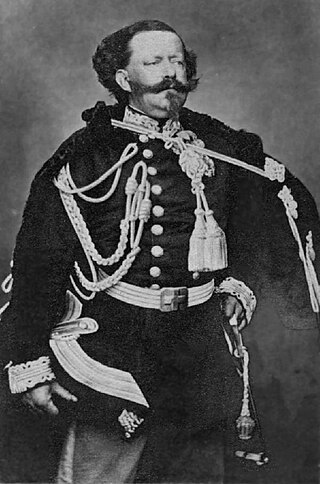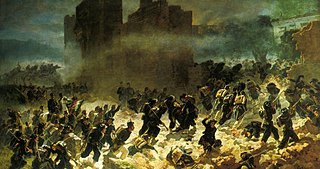
The unification of Italy, also known as the Risorgimento, was the 19th-century political and social movement that resulted in the consolidation of different states of the Italian Peninsula into a single state in 1861, the Kingdom of Italy. Inspired by the rebellions in the 1820s and 1830s against the outcome of the Congress of Vienna, the unification process was precipitated by the Revolutions of 1848, and reached completion in 1871 after the Capture of Rome and its designation as the capital of the Kingdom of Italy.

Victor Emmanuel II was King of Sardinia from 1849 until 17 March 1861, when he assumed the title of King of Italy and became the first king of an independent, united Italy since the 6th century, a title he held until his death in 1878. Borrowing from the old Latin title Pater Patriae of the Roman emperors, the Italians gave him the epithet of Father of the Fatherland.

The Lateran Treaty was one component of the Lateran Pacts of 1929, agreements between the Kingdom of Italy under King Victor Emmanuel III of Italy and the Holy See under Pope Pius XI to settle the long-standing Roman Question. The treaty and associated pacts were named after the Lateran Palace where they were signed on 11 February 1929, and the Italian parliament ratified them on 7 June 1929. The treaty recognized Vatican City as an independent state under the sovereignty of the Holy See. The Italian government also agreed to give the Roman Catholic Church financial compensation for the loss of the Papal States. In 1948, the Lateran Treaty was recognized in the Constitution of Italy as regulating the relations between the state and the Catholic Church. The treaty was significantly revised in 1984, ending the status of Catholicism as the sole state religion.

The temporal powerof the Holy See designates the political and secular influence of the Holy See, the leading of a state by the pope of the Catholic Church, as distinguished from its spiritual and pastoral activity.
A prisoner in the Vatican or prisoner of the Vatican described the situation of the Pope with respect to Italy during the period from the capture of Rome by the armed forces of the Kingdom of Italy on 20 September 1870 until the Lateran Treaty of 11 February 1929. Part of the process of Italian unification, the city's capture ended the millennium-old temporal rule of the popes over central Italy and allowed Rome to be designated the capital of the new nation. Although the Italians did not occupy the territories of Vatican Hill delimited by the Leonine walls and offered the creation of a city-state in the area, the Popes from Pius IX to Pius XI refused the proposal and described themselves as prisoners of the new Italian state.

Luigi Carlo Farini was an Italian physician, statesman and historian.

Massimo Taparelli, Marquess of Azeglio, commonly called Massimo d'Azeglio, was a Piedmontese-Italian statesman, novelist and painter. He was Prime Minister of Sardinia for almost three years, until his rival Camillo Benso, Count of Cavour succeeded him. D'Azeglio was a moderate liberal who hoped for a federal union between Italian states. As Prime Minister, he consolidated the parliamentary system, getting the young king to accept his constitutional status, and worked hard for a peace treaty with Austria. Although himself a Roman Catholic, he introduced freedom of worship, supported public education, and sought to reduce the power of the clergy in local political affairs. As senator, following the annexation of the United Provinces of Central Italy, Azeglio attempted to reconcile the Vatican with the new Italian Kingdom. His brother Luigi Taparelli d'Azeglio was a Jesuit priest.

The Roman question was a dispute regarding the temporal power of the popes as rulers of a civil territory in the context of the Italian Risorgimento. It ended with the Lateran Pacts between King Victor Emmanuel III of Italy and Pope Pius XI in 1929.
This is a timeline of the unification of Italy.

The Capture of Rome on 20 September 1870 was the final event of the unification of Italy (Risorgimento), marking both the final defeat of the Papal States under Pope Pius IX and the unification of the Italian Peninsula under the Kingdom of Italy.

The Kingdom of Italy was a state that existed from 1861, when Victor Emmanuel II of Sardinia was proclaimed King of Italy, until 1946, when civil discontent led to an institutional referendum to abandon the monarchy and form the modern Italian Republic. The state resulted from a decades-long process, the Risorgimento, of consolidating the different states of the Italian Peninsula into a single state. That process was influenced by the Savoy-led Kingdom of Sardinia, which can be considered Italy's legal predecessor state.

Agostino Bertani was an Italian revolutionary and physician during Italian unification.

International relations between France and the Italy occur on the diplomatic, political, military, economic, and cultural level, officially the Italian Republic, and its predecessors, the Kingdom of Sardinia (Piedmont) (1814–1861) and the Kingdom of Italy (1861–1946).

Italian nationalism is a movement which believes that the Italians are a nation with a single homogeneous identity, and therefrom seeks to promote the cultural unity of Italy as a country. From an Italian nationalist perspective, Italianness is defined as claiming cultural and ethnic descent from the Latins, an Italic tribe which originally dwelt in Latium and came to dominate the Italian peninsula and much of Europe. Because of that, Italian nationalism has also historically adhered to imperialist theories. The romantic version of such views is known as Italian patriotism, while their integral version is known as Italian fascism.
General elections were held in Italy on 27 January 1861, with a second round on 3 February. The newly elected Parliament first convened in Turin on 4 March 1861, where, thirteen days later, it declared the unification of the country as the Kingdom of Italy.
The Right group, later called Historical Right by historians to distinguish it from the right-wing groups of the 20th century, was an Italian conservative parliamentary group during the second half of the 19th century. After 1876, the Historical Right constituted the Constitutional opposition toward the left governments. It originated in the convergence of the most liberal faction of the moderate right and the moderate wing of the democratic left. The party included men from heterogeneous cultural, class, and ideological backgrounds, ranging from Anglo-Saxon individualist liberalism to Neo-Hegelian liberalism as well as liberal-conservatives, from strict secularists to more religiously-oriented reformists. Few prime ministers after 1852 were party men; instead they accepted support where they could find it, and even the governments of the Historical Right during the 1860s included leftists in some capacity.

Camillo Paolo Filippo Giulio Benso, Count of Cavour, Isolabella and Leri, generally known as Cavour, was an Italian politician, businessman, economist and noble, and a leading figure in the movement towards Italian unification. He was one of the leaders of the Historical Right and prime minister of the Kingdom of Piedmont–Sardinia, a position he maintained throughout the Second Italian War of Independence and Giuseppe Garibaldi's campaigns to unite Italy. After the declaration of a united Kingdom of Italy, Cavour took office as the first prime minister of Italy; he died after only three months in office and did not live to see the Roman Question solved through the complete unification of the country after the Capture of Rome in 1870.

The Plombières Agreement of the 21 July 1858 was a secret verbal agreement which took place at Plombières-les-Bains between the chief minister of Piedmont-Sardinia, Count Cavour, and the French Emperor, Napoleon III. Some older English languages refer to it as the Treaty of Plombières. In modern times, it is merely referred to as an "agreement", since nothing was actually signed.
The Law of Guarantees, sometimes also called the Law of Papal Guarantees, was the name given to the law passed by the senate and chamber of the Italian parliament, 13 May, 1871, concerning the prerogatives of the Holy See, and the relations between State and Church in the Kingdom of Italy. It guaranteed sovereign prerogatives to the Roman Pontiff, who had been deprived of the territory of the papal states. The popes refused to accept the law, as it was enacted by a foreign government and could therefore be revoked at will, leaving the popes without a full claim to sovereign status. In response, the popes declared themselves prisoners of the Vatican. The ensuing Roman Question was not resolved until the Lateran Pacts of 1929.

The Royal Sardinian Navy was the naval force of the Kingdom of Sardinia. The fleet was created in 1720 when the Duke of Savoy, Victor Amadeus II, became the King of Sardinia. Victor Amadeus had acquired the vessels be used to establish the fleet while he was still the King of Sicily in 1713. The Sardinian Navy saw action in a number of conflicts, including the French Revolutionary Wars and the Napoleonic Wars from the 1790s to 1810s, limited actions against the Barbary Coast such as the Battle of Tripoli in 1825, and the Second Italian War of Independence in 1859. The last war was a major step toward Italian unification, which led to the creation of a united Italian state in 1861. During the fighting in 1860, the Royal Neapolitan Navy defected to Sardinia and placed itself under Sardinian control; in 1861, the navy also absorbed the Royal Sicilian Navy, resulting in the creation of the Regia Marina, which itself became the Marina Militare, the modern Italian navy, in 1946.
















